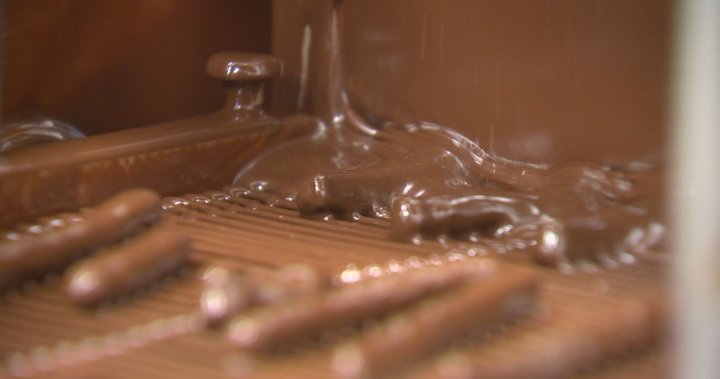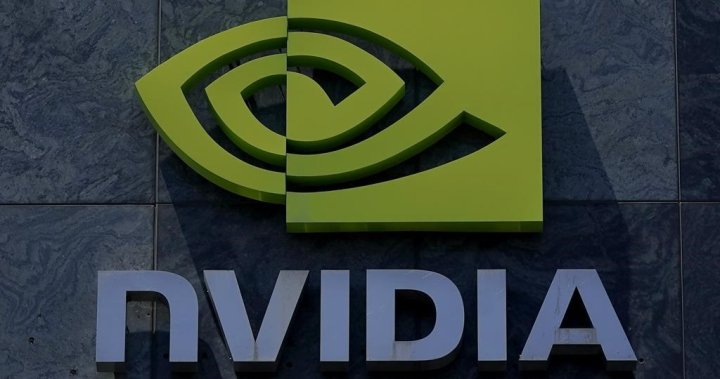“Forget love … I’d rather fall in chocolate!”
It’s an anonymous saying but a trip to Bernard Callebaut’s Master Chocolat in Calgary has customers ready to take a dip. Maria Messier says she is a regular.
“We love Master Chocolat for many years. We have six grandchildren every year we come here for every special occasion.”
Bernard Callebaut’s passion has been chocolate for 41 years. He still makes Easter Bunnies for kids of all ages.
“You bet. I get up early at 5 o’clock in the morning and I still love what I am doing. I really do,” Callebaut said.
But a huge jump in the price of cocoa beans will demand a price increase, Callebaut said — even if he can hold the line for now until supplies run out.
“We are okay, but ultimately in the long-term, anyone in the chocolate industry will have to raise their prices.”
Callebaut said the price per tonne for cocoa has doubled in the past three months and recently set a record high.
“In February of 2023, so like a little over a year ago, the price was $2,600 a tonne. This Tuesday it was just over $10,000(USD).”

Why have prices skyrocketed?
Cocoa futures have “gone vertical” this year, especially in the last four or so months, said Graeme Crosbie, senior economist at agriculture lending firm Farm Credit Canada.
Futures are a way of measuring commodity prices based on contracts for future delivery, a common way to track prices for commodities like wheat, gold and oil.
A February report by agriculture-focused co-operative bank CoBank said cocoa prices were nearly 65 per cent higher than a year ago, and New York futures prices were at a 46-year high.
Bad weather and disease in West Africa have damaged crop yields, said Crosbie, hurting supply for the product that goes into Halloween, Valentine’s Day and Easter candy.
Most cocoa, especially the cocoa found in many popular chocolate products, comes from West Africa.
Breaking news from Canada and around the world
sent to your email, as it happens.
Côte D’Ivoire saw a 30 per cent decline in production over the past year due to climate change and disease, according to Sophia Carodenuto — a professor of geography at the University of Victoria whose research specializes in global food systems.
Unlike some crops, cocoa production is highly concentrated, meaning huge portions of the world’s supply are grown in a handful of areas, said Crosbie. This makes the crop and its supply chain more vulnerable to disruptions.
Callebaut agrees the bean shortage has been brought on by climate change, El Nino and farmers in Côte d’Ivoire and Ghana in West Africa — which supplies 60 per cent of the world’s cocoa market — leaving the industry.
“Because they don’t make enough money.
“I think keeping the price high is good because it will keep people in the industry — otherwise, there will be no chocolate anymore.”
Higher cocoa prices are an obstacle for manufacturers who have already been struggling with higher sugar prices over the past three years, said senior food and beverage economist Billy Roberts in the CoBank press release.
“That could lead to a further erosion of chocolate volume sales and begin to impact dollar sales as well,” he said.

Cocoa futures not reflected in farmer’s income
Higher commodity futures also don’t necessarily dictate the prices farmers are being paid in real time, noted Carodenuto.
In Ghana and Côte D’Ivoire, the largest-producing countries for cocoa, the government creates a minimum price for farmers for the season, she said.
But the large multinational companies buying and trading cocoa enter into forward contracts, meaning prices are agreed upon in advance.
Callebaut says farmers get about 30 to 50 per cent of the price of the beans and an average farm yield is about a tonne. So even with a record high of $10,000 a tonne — the yearly salary is still only $3,000 to $5,000.
It takes a lot of manual labour and investment to build a cocoa farm, so farmers need support, especially financially, Carodenuto said.
There’s hope that the higher futures prices will lead to more income next year, but it’s not a guarantee, she added — cocoa prices are cyclical, meaning there will likely be a price crash at some point.
Ethical choice vs. affordability
Consumers looking to make ethical spending decisions face a difficult choice, said Carodenuto, especially given the price gap between premium and ethically sourced chocolate and popular, mass-market confections.
Carodenuto said shoppers don’t need to stop buying chocolate, but they should educate themselves and seek supply chain transparency by looking for the origin of the cocoa in a product.
Shoppers who can afford to spend more can also seek out businesses that specialize in sourcing ethical cocoa products, she said.
Callebaut said he has an ethical supplier and buys his beans from Central America, but supports the price increase to protect African farmers.
The Calgary chocolate maker said he accepts what will come.
A long-time customer, Elaine Teodoro says price increases everywhere means she has to be very selective in her buying. But quality chocolate from Master Chocolat will remain on the menu.
“If, for him to survive, the prices need to go up — unfortunately that’s what’s going to have to be,” Teodoro said.
“The farmers do need to get paid better.”
Maria Messier agrees.
“If it goes higher and more expensive, I will still come here.”
Cocoa prices don’t directly translate to retail prices, since there are many things other than cocoa that make up a chocolate bar, Crosbie said. But they do have an effect, and he expects retail prices to increase.

Callebaut said the giants of the industry will likely keep their market share with less expensive ingredients (a move known as skimpflation) and shrinkage is already occurring.
But for the chocolatier, changing what goes into his product is unthinkable.
“No — no, that is a no-go. I have been making chocolate for 41 years. I am not changing.”
— With files from Rosa Saba, The Canadian Press




